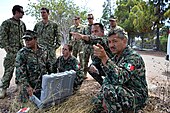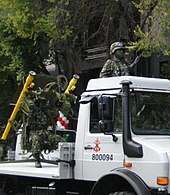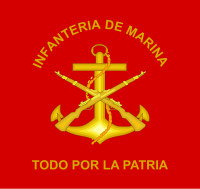|
Naval Infantry Corps
  The Naval Infantry Corps (Spanish: Cuerpo de Infantería de Marina), also referred to as the Mexican Marines, are the naval infantry force of the Mexican Navy. The main task of the Infantería de Marina is to guarantee the maritime security of the country's ports and external and internal defense of the country. To accomplish these responsibilities, the corps is trained and equipped to take on any type of operations from sea, air and land.[1] The Naval Infantry Corps is additionally responsible for Mexico's naval special operations forces (SOF), managing the Unidad de Operaciones Especiales (Mexican Navy Special Operations Unit),[2] itself responsible for, among other units, the Fuerzas Especiales (Special Forces), the Mexican Navy's Tier 1 SOF unit. The Naval Infantry Corps was reorganized in 2007–2009 into 30 Naval Infantry Battalions (Batallones de Infantería de Marina—BIM), a paratroop battalion, a battalion attached to the Presidential Guard Brigade, two fast reaction forces with six battalions each, and three special forces groups.[3] The Naval Infantry are responsible for port security, protection of the ten-kilometer coastal fringe, and patrolling major waterways. MissionTo accomplish the necessary services and tasks, the Naval Infantry's overall responsibilities are to develop amphibious naval capabilities in the areas of operations of the navy in order to mobilize naval troops immediately and decisively. The Naval Infantry execute the following tasks:
HistoryThe roots of the Naval Infantry Corps can trace its roots to the independence of Mexico in 1821. Between 1821 & 1822, independent Mexico created the Secretariat of the Admiralty headed by Don Agustín de Iturbide, who assigned the first units of the Mexican Army, which consisted of four battalions, two of them classified as "Marina" stationed in San Blas and Veracruz.[5]
Mexican Drug War           Since the start of President Felipe Calderón's war on the drug cartels, the Infantería de Marina's role has grown from maritime and port security to land based operations in combating organized crime, drug trafficking, extermination of marijuana fields, drug interdictions at sea, and also participating in arrest of cartel suspects.[6] The Navy has carried out permanent intense anti-narcotic operations. Such tasks as the extermination of marijuana fields which mostly takes place in the north-western part of the country is done by first locating the fields by satellite or simply by air reconnaissance, then sending a team of Marines to eradicate the cannabis plants.[7] One of its big seizures was in late October 2007, when Navy personnel in a joint operation with other agencies seized 23 tons of cocaine in the port city of Manzanillo, Colima.[8][9] Due to its actions, the Navy and in kind the Naval Infantry Force has risen in stature in the United States.[10] Narco submarine interceptionDrug interdiction at sea is also part of the Navy's strategy to combat drug trafficking, this came to light when, on July 16, 2008, the Navy intercepted a 10-metre-long (33 ft) narco submarine travelling about 200 kilometres (120 mi) off the southwest of the state of Oaxaca; in a raid, Navy Special Forces rappelled from a helicopter on to the deck of the narco submarine and arrested four smugglers before they could scuttle their vessel. The vessel was found to be loaded with 5.8 tons of cocaine and was towed to Huatulco, Oaxaca, by a Navy patrol boat.[11][12][13][14][15] Hurricane Katrina reliefMexico sent marines to the U.S. in 2005 for disaster relief after Hurricane Katrina. SymbolsEmblemThe shield anchor, crossed with the carbine, has been part of the Naval Infantry since 1823. The shield of the Naval Infantry, as today, is the essence of their integration into the meaning of heraldry. Examples are the gold trim, which gives nobility, seriousness and elegance; the Admiralty anchor, which symbolizes belonging to the Navy; and finally crossed muskets, symbolizing the weapons used by the first generation personnel of the Naval Infantry strengthening the country as a nation-state, free and sovereign. Together they represent the dedication to serve Mexico by air, land and sea. The color red has always characterized the Marines around the world. BannerThe Iconography of the Marines of Mexico has developed a description of the standard as follows: at the center, the Marine Shield with its original colors, scarlet red cloth with gold-colored robes. In addition to being waved at official ceremonies, the Corps Standard (Estandarte) is present in all parades wherein the Corps takes part as a constituent branch of the navy proper. The corps standard is also present in the Corps Headquarters, all unit bases and in the Secretariat of the Navy. Organization and roleThe overall head of the Naval Infantry is the president of Mexico Andrés Manuel López Obrador, in his role as commander-in-chief of the Mexican Armed Forces. Operational control of the NIF falls under the responsibility of the Secretary of the Navy. The navy is defined in its strategic review by the status of Mexico as a coastal state, highlighting the importance of its borders with the United States of America, Belize and Guatemala, and identifying areas of strategic importance such as the Caribbean and the Yucatán Channel, for their transit of maritime trade is of great importance for the country, without forgetting that it is also an area crowded by tourist cruises that visit Mexican ports and their use as a runner and high rate of drug trafficking activities. The Bay of Campeche, which is distinguished by its deposits of oil and marine resources and the enormous network of oil and gas pipelines between the production platforms and destinations on the coast, the Isthmus of Tehuantepec and the Gulf area by sea and land are considered as a future strategic development of the country, industrial corridor and gateway between the Pacific and Gulf of Mexico; the Grijalva Hydroelectric Complex is considered an important center of power generation in the country; and the Gulf of California has ecological importance and tourist influence, as well as activities of a drug trafficking corridor. To meet the operational requirements of the navy, it was necessary to create the structure of a reaction force with organizational skills focusing on: flexibility, multi-tactical use of rapid response, firepower, mobility and economy of forces, in addition to the efforts of support for transport by air, sea and land, to the missions and tasks assigned by the navy to fulfill its mission. Therefore, the Amphibious Marine Reaction Force is defined as an organized force, equipped and trained as a component part of a Naval Force to develop operations in the immediate response missions that are assigned. It falls into an operational concept which states that given the need to respond as a projection of naval power, it requires that their actions be limited by an autonomous period of time. According to the task, units are integrated to meet requirements identified in a variety of operational environments; their capacity to be transported by sea, air, and land are organic to the unit. Therefore, the flexibility of its organizational units can integrate in different areas of operations such as amphibious combat, desert and mountain combat, urban operations in the jungle, night airborne assault, and vertical river of interdiction raids, in addition to other civic action operations and support to other units when ordered. StructureAfter reorganization, the Marine forces were deployed under a new strategic operational concept with specific functions, including in the navy to the following Marine Corps units:[16]
There are two Marine Amphibious Groups (the Gulf and Pacific), which have replaced the two Reaction Amphibious Forces, whose mission is the defense of national coastlines against any conventional aggression. Each has a total manpower of 3,000 men. Both are composed of two Amphibious Battalions of Marines, a Battalion of Marines Commandos, a Marine Artillery Battalion, an Amphibious Vehicles and Vessels Battalion, which includes 12 armored APC-70, and a Service Battalion. The 24th Marine Battalion "Presidential Guards", created in 1983, is responsible for providing security to the president. It is quartered in the Mexico City, like the BIMFUSPAR (Marine Parachute Fusilier Battalion). Finally there are 3 Marine Special Forces Groups (Strength, Spirit and Wisdom is their motto). The FESGO (Special Forces Gulf) and the FESPA (Special Forces Pacific), both destined for missions in support of the then new Amphibious Forces Reaction In 2008, formed the FESCEN (Special Forces Center), based in Mexico City, whose purpose is to provide the High Command Headquarters a grouping of special forces mission critical. While FESGO and FESPA have an effective of 220 marines each, the FESCEN has less than 160 personnel. The Marine Parachute Battalion is an elite force, which is the strategic reserve of the High Command of the Mexican Navy for high impact operations and emergency. The organizational and operational needs motivated the creation of BIMFUSPAR in 1992. The new unit was championed by then-President Carlos Salinas de Gortari, on June 1, 1994. The Battalion is divided into three Marine Paratrooper Rifle Companies, a Weapon Support Company and a Command Group. The Company Headquarters and Services is integrated into the grouping of services 7th Marine Brigade, which belongs since 2010. Each Marine Battalion has three Marine Infantry Companies, a Company of Support Weapons (mortars, rocket launchers and machine guns) and Services. Each Company has three Sections, each of three Platoons, which are themselves composed of thirteen elements in three Squads of four men under the command of a Third or Second Master. The Squads are formed by a Corporal Squad Leader, a rifleman grenadier armed with M16A2 and M203 40 mm grenade launcher, a submachine gunner with a Colt RO 750 LSW 5.56 mm. and a rifleman with a standard M16A2. The organization of a Platoon at three Squads, a Section in three Platoons and a Company into three Sections responds to the need in any case with the three decisive factors in combat: assault element, the support and security. Special Forces UnitsFuerzas Especiales (FES), (Special Forces), is a Special Operations Unit of the Navy officially established in late 2001. Equipment
References
External linksWikimedia Commons has media related to Mexican Naval Infantry.
|
||||||||||||||||||||||||||||||||||||||||||||||||||||||||||||||||||||||||||||||||||||||||||||||||||||||||||||||||||||||||||||||||||||||||||||||||||||||||||||||||||||

